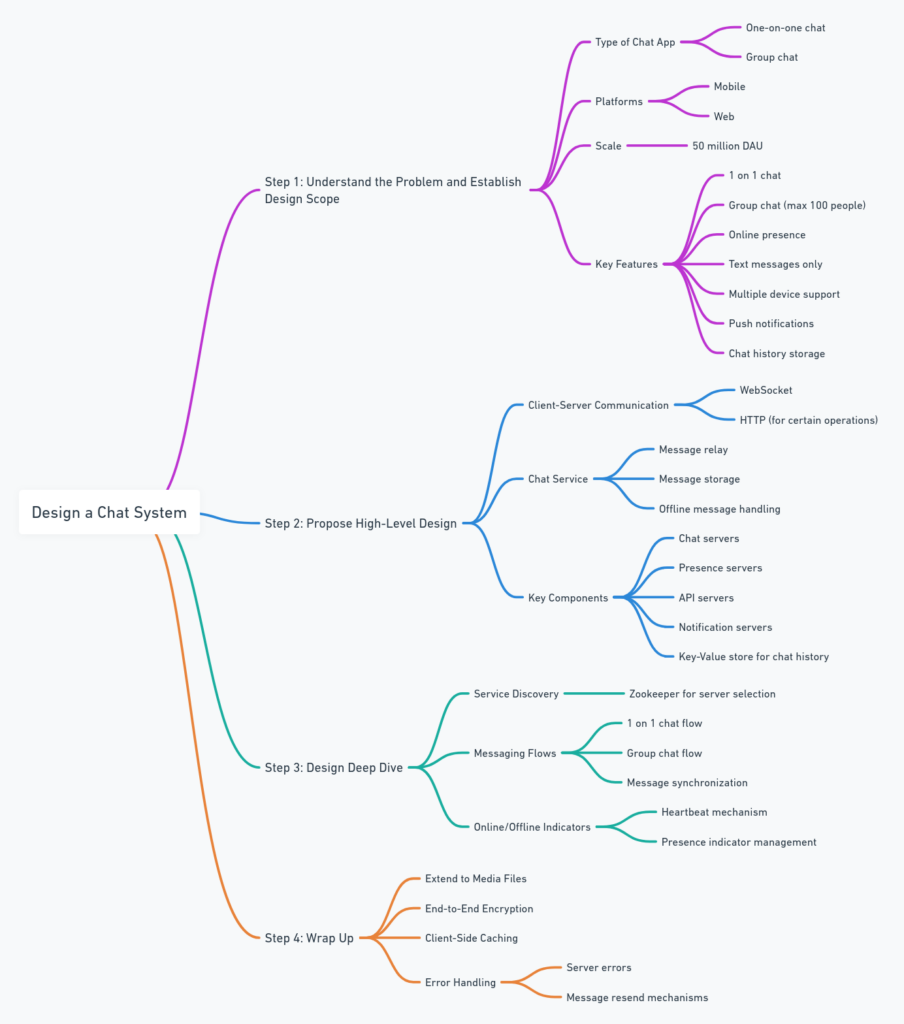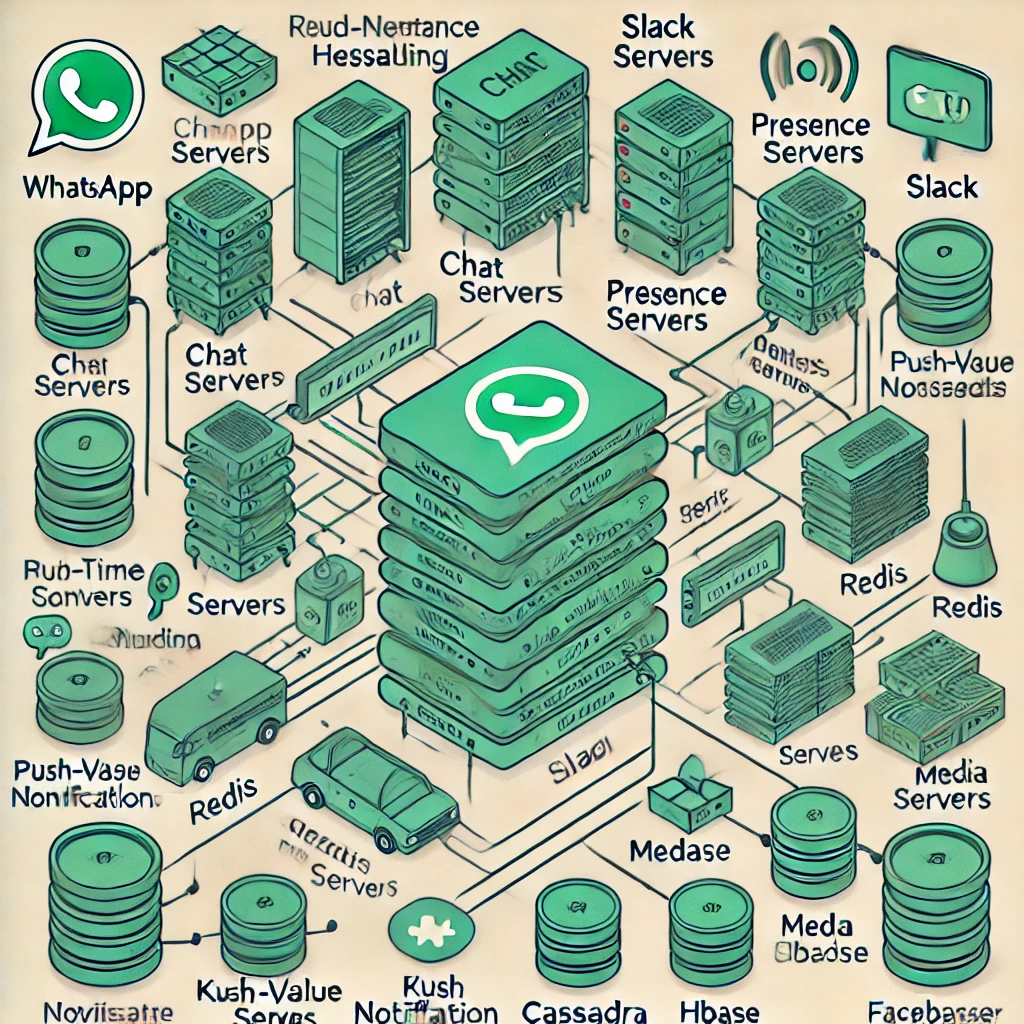This is my reading notes for Chapter 10 in book “System Design Interview – An insider’s guide (Vol. 1)”.
Overview
This Chapter delves into the design of a chat system, drawing inspiration from real-world applications such as WhatsApp, Slack, and Facebook Messenger. It covers a comprehensive approach to architecting a chat service that handles millions of users efficiently. The chapter provides a clear breakdown of client-server interactions, scaling strategies, and persistence mechanisms for reliable communication.

Detailed Breakdown
- Requirement Gathering:
- The first step in designing a chat system is to fully understand the requirements. The chapter suggests asking key questions to clarify the scope:
- Should the system support one-on-one chats, group chats, or both?
- What features should be supported (e.g., message read receipts, push notifications, file sharing, online status, encryption)?
- How many users should the system scale to handle? In the example, the goal is to support 50 million DAU (daily active users).
- Example: If designing for a business context (like Slack), group chat becomes a major focus with features like multi-device sync, search functionality, and data retention policies. For a social chat app (like WhatsApp), the emphasis could be on end-to-end encryption and media sharing.
- The first step in designing a chat system is to fully understand the requirements. The chapter suggests asking key questions to clarify the scope:
- Core System Components:
- Chat Servers: These are responsible for maintaining real-time connections with clients. They handle message transmission, ensuring messages are delivered either instantly or stored for later delivery if the recipient is offline.
- Example: In WhatsApp, chat servers manage real-time message delivery over WebSockets, while in Slack, the servers coordinate between users in channels.
- Presence Servers: Manage user status (e.g., online, offline, or away) and propagate these changes across clients.
- Push Notification Servers: Notify users about incoming messages, especially when they are offline or the app is in the background. These are essential for mobile-first applications like iMessage and Facebook Messenger.
- Key-Value Stores (Databases): Store chat history and message metadata. Popular choices include NoSQL databases like Cassandra (used by Discord) or HBase (used by Facebook Messenger) to handle the large volume of data efficiently.
- Chat Servers: These are responsible for maintaining real-time connections with clients. They handle message transmission, ensuring messages are delivered either instantly or stored for later delivery if the recipient is offline.
- Communication Protocols:
- WebSocket vs. HTTP:
- WebSocket is preferred for real-time, bidirectional communication between the client and the server, maintaining a persistent connection for active users.
- HTTP is used for initial client requests such as login and other non-real-time operations. Once authenticated, WebSocket takes over to manage real-time communication.
- Example: Facebook Messenger uses WebSockets for real-time communication but reverts to HTTP for operations like fetching older message histories.
- WebSocket vs. HTTP:
- Message Flow:
- One-on-One Chat Flow:
- When a message is sent, it is passed to the chat server, assigned a unique message ID, and forwarded to the recipient. If the recipient is offline, the message is saved in persistent storage (e.g., Redis, Cassandra) and delivered when they come online.
- Group Chat Flow:
- Group chats introduce more complexity due to the need for message distribution to multiple recipients. Each recipient has a “message sync queue” where messages are stored until retrieved.
- Example: In Slack, when a message is sent to a channel, it is copied to each group member’s queue. However, Slack optimizes this by using a “publish-subscribe” model to avoid duplicating messages unnecessarily.
- One-on-One Chat Flow:
- Data Storage and Retrieval:
- Key-Value Stores: For efficiency, chat messages are typically stored in a key-value store, such as Redis, Cassandra, or HBase. Messages are keyed by unique message IDs or user IDs.
- Example: Facebook Messenger uses HBase, a columnar NoSQL database, to store massive amounts of chat data while ensuring quick retrieval times.
- Message Schema: The design encourages separating one-on-one chat messages from group chat messages to ensure scalability and retrieval speed. One-on-one messages could be keyed by
sender_id:receiver_id, while group chat messages could be stored bygroup_id.
- Scalability Strategies:
- Load Balancing: The chat servers need to be load-balanced to handle millions of connections. This can be done using a service discovery tool (e.g., Zookeeper) that routes clients to the optimal server based on geographical proximity and server load.
- Sharding: Messages can be sharded based on user ID or group ID to distribute the load across multiple servers.
- Example: Discord employs sharding to ensure that chat data is evenly distributed across databases, reducing the load on any single database instance.
- Data Replication: Messages are often replicated across multiple data centers for redundancy and low latency. If one data center fails, the system can switch to another data center seamlessly.
- Example: WhatsApp replicates its data across multiple regions to ensure that messages are quickly delivered, regardless of the user’s location.
- Handling Presence and Status:
- Heartbeat Mechanism: To ensure clients remain connected, a heartbeat message is sent periodically between the client and the chat server. If the server fails to receive a heartbeat within a certain timeframe, it marks the user as offline.
- Example: Slack uses heartbeat signals to manage online presence across multiple devices for the same user. If the signal is lost, the app marks the user as offline.
- Publish-Subscribe Model: This model is commonly used to broadcast user presence status changes to connected clients efficiently. For example, when a user comes online, all friends are notified.
- Heartbeat Mechanism: To ensure clients remain connected, a heartbeat message is sent periodically between the client and the chat server. If the server fails to receive a heartbeat within a certain timeframe, it marks the user as offline.
- Advanced Features and Enhancements:
- Media File Handling: Chat systems can be extended to support media sharing (images, videos, documents). This requires a separate media server to handle uploads, storage, and content distribution via CDN (Content Delivery Network).
- End-to-End Encryption: To ensure privacy, especially in apps like WhatsApp and Signal, messages are encrypted before being sent and decrypted only by the recipient.
- Message Retries: In cases where message delivery fails (e.g., due to network issues), retry mechanisms can ensure eventual delivery, even after multiple failures.
- Fault Tolerance and Reliability:
- Disconnection Handling: In the event of a client disconnection (e.g., due to network issues), the system should be capable of gracefully handling reconnections without message loss. Reconnect logic and message queuing help mitigate these problems.
- Redundancy: Redundant servers and database replication ensure the system can handle server or network failures without disrupting the user experience.
Key Takeaways
- Real-Time Communication: WebSockets are essential for real-time chat systems due to their ability to maintain persistent, low-latency connections. However, fallback mechanisms (such as HTTP polling) are necessary to ensure reliability in the case of WebSocket failures.
- Scalability and Reliability: As the system grows, scalability must be achieved through methods like load balancing, sharding, and distributed databases. Redundancy is crucial for handling failures, and message replication ensures that even in cases of server failure, messages are not lost.
- Efficiency of Data Storage: Using key-value stores like Redis, Cassandra, or HBase ensures that chat history is stored efficiently and retrieved quickly. Sharding by user ID or group ID helps distribute the load and prevents bottlenecks.
- Presence Management: A presence server with a publish-subscribe model ensures that user status changes are broadcasted efficiently. Heartbeat mechanisms help manage connection status, ensuring that users are accurately shown as online or offline.
- Feature Expansion: While the core system handles text messages, adding features like media sharing, encryption, and retries for failed messages increases the system’s complexity but enhances the user experience.
Conclusion
Chapter 12 of System Design Interview provides a detailed guide for designing a scalable, real-time chat system, from clarifying requirements to handling complex scenarios such as large group chats and multi-device synchronization. The chapter serves as a solid framework for tackling system design interviews by focusing on clear, high-level architecture, supported by scalable, robust components.


Its good as your other content : D, regards for posting. “Too much sensibility creates unhappiness too much insensibility leads to crime.” by Charles Maurice de Talleyrand.
There’s definately a great deal to learn about this subject. I love all of the points you have made.
Bookmarking this for my research notes.
Super helpful and straight to the point.
This clarified so much for me.